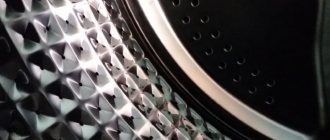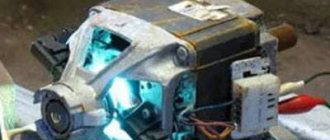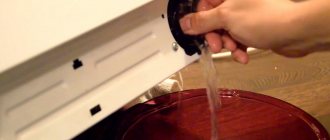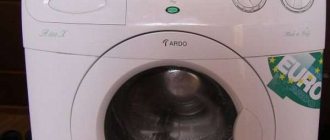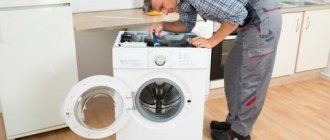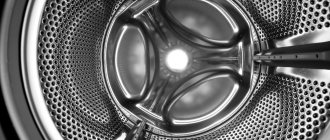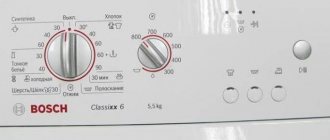What should you do if one day, when you decide to wash your clothes and connect the washing machine to the network, you find that it does not work? When trying to understand the cause of the malfunction, it is necessary to establish how the equipment reacts when turned on. In total, two problems can be identified: the device does not react at all, the display does not light up, the lights do not blink; The machine turned on, but none of the programs started. Next, we will try to figure out what caused the malfunction, why the washing machine does not turn on, and what should be done in this situation.
About additional details
Front-type counterweights are present only on some models. This is necessary to compensate for the imbalance. The shape, material, and weight of such inserts may vary.
The counterweights themselves are blocks with a fairly large weight. They can be plastic or concrete. The latter have a serious drawback - the ability to deteriorate and crumble over time. But most often serious problems arise due to mounting on counterweights. Because of them, the seat of the bolts is destroyed.
To transfer torque from the electric motor to the drum, you need a special belt. Most often, rubber is used to make such parts. But some manufacturers put belts made of polyurethane, neoprene and nylon inside their cars.
Drive belts are available in several varieties:
- groups Z – almost every device from Russia is supplied with them;
- H – found in small cars;
- J is a diagram for devices with large dimensions;
- 3 L – found in foreign analogues. LG, for example.
A wheel is fixed to the drum shaft, which is called the driven drum pulley. It also participates in transmitting the movement of the drive belt. The diameter of this structure determines what the maximum number of revolutions in the machine will be during operation. Aluminum alloys are very fragile materials, from which this pulley is almost always cast. This also applies to Ardo models.
Asynchronous motor malfunctions
There are several causes of malfunctions and their diagnosis for an asynchronous motor, which are combined in the table:
| Deviations in engine operation | What to do |
| The engine does not run at low speed. | Measure the resistance of the windings; check the capacitor. |
| The engine does not run at high speed. | Measure the resistance of the windings; check the capacitor. |
| The engine does not run at any speed. | Measure the resistance of the windings; check the capacitor. |
| The engine does not run stably, its thermostat switches and turns off. | After turning off the engine, measure the winding resistance. |
| Knocks out the machine gun. | Check for leakage on the housing; check the resistance between all motor contacts and its housing. |
| Loud engine noise |
|
| The engine does not turn over and hums. | Check the capacitor. |
Malfunctions of the electric motor of the Indesit washing machine
Malfunction of the electric motor of the washing machine Zanussi fe 804
How to replace brushes in a washing machine
Before you start replacing the brushes, it's worth watching the video.
Even a reliable and durable Ardo washing machine requires regular inspection and replacement of worn parts. After 5 years of operation, it may be necessary to replace the motor brushes, which may lose full contact.
If a malfunction is detected in the electric motor of an Ardo 1000 washing machine associated with replacing the motor brushes, you must purchase the following set of tools and accessories:
- New brushes.
- Multimeter.
- Screwdrivers.
- An ordinary vacuum cleaner.
Instructions for replacing motor brushes:
- The washing machine is de-energized;
- This frees up space near the rear wall of the unit for ease of work;
- The back wall is removed after unscrewing the screws holding it;
To determine the placement of the electric motor in a washing machine, you need to locate the drum pulley, and then the motor and the drive belt that connects them. The belt is removed after prying it off with a screwdriver and turning the pulley.
- Before removing the engine from the car, disconnect the power connector from it and unscrew the screws;
- The motor is removed;
- The engine is wiped or vacuumed, which may become covered with graphite dust, interfering with further procedures;
- The engine is tested for leaks and short circuits to the frame. The most convenient way to do this is with a multimeter;
- Remove power from the contacts of the brush holders by pressing on them;
- The contacts are pulled out of the motor housing;
- Brush wear is determined by the size of the graphic area: if its size is less than 5 mm, replacement must be done;
- The new brush is ground into the commutator by placing sandpaper on it and turning it a few turns;
- The same procedure is repeated with the second brush;
- The engine is vacuumed again;
- The motor is completely assembled and installed in the Ardo washing machine;
At this stage, a drive belt is not needed. The machine simply starts in washing mode. This must be done so that the brushes rub well into the engine commutator.
- The drive belt is put on the engine pulley, and then on the drum pulley;
- The washing machine is completely assembled;
- The back wall is installed and secured.
In the same way, faults in the electric motors of tl washing machines are eliminated.
Break and short circuit of stator and rotor windings
When the engine power decreases, a short circuit may have occurred between the turns of the winding. In this case, the machine drum may stop rotating or rotate slowly.
When the engine stopped, most likely there was a break in the stator windings. This can happen when the motor housing heats up too much, which is caused by a short circuit in the motor windings. When the engine heats up to a temperature above 90ºС, a special protective thermostat is activated.
To check for an open circuit in the windings, you can use a tester in ohmmeter mode connected to adjacent lamellas. In different positions of the shaft between the lamellas, the resistance of adjacent elements should be the same - from 0.1 to 0.4 Ohm.
A short circuit in the motor winding may occur if the insulation is damaged. In this case, you will need to change the entire motor, or create the winding again, but this is very difficult. A short circuit in the engine can also cause other problems.
Is the program switch knob working?
A non-functioning programmer can prevent the cycle from starting. When selecting and switching modes, the selector must be locked in the desired position. If the handle is faulty, this does not happen and the user cannot set the necessary washing parameters. Therefore, the machine does not start working. The programmer in many models is an integral part of the timer. However, this does not prevent you from checking the selector with a multimeter. What to do in this situation:
- turn off the power to the automatic machine;
- remove the “top” of the case by unscrewing a couple of bolts holding the cover;
- inspect the electrical circuit of the device;
- find the selector contacts;
- use a tester to ring the contacts.
Some modern Ardo machines have a digital selector. In this case, the device is not tied to the timer, but is built into the control board circuit. Here the programmer is more difficult to check - you need to apply the multimeter probes by activating the “Start” key.
Minor damage
In a situation where Ardo refuses to turn on, it is necessary to inspect the equipment for possible damage or malfunctions. You need to start with the simplest reasons, which are located under points 1 and 2 above.
The washing machine remains in place during the inspection. First of all, if the Ardo machine refuses to turn on, you will need to perform the following steps.
- Check the outlet. To do this, you need to remove the plug from the socket and connect another electrical device to it. The verification method is quite simple. The socket is considered broken if the connected device refuses to turn on.
- If the outlet works, you need to check the extension cord where the cord of the Ardo machine goes. The verification method is the same as above.
- The next element of inspection will be the network cable. If damage to the insulating layer is detected, and traces of melting are also noticed, the cord must be replaced. Its further operation is impossible. Otherwise, this may cause the Ardo machine to stop turning on and working.
- Finally, if you cannot see any damage, you can check the wire using a multimeter. To do this, you must first set the device to the minimum resistance value, and then touch the probe to one of the teeth (usually the right one) of the fork. The standard resistance value for an Ardo machine is 2 ohms. Any deviation indicates that the plug needs to be replaced.
It is also worth noting that if defects are detected in the network cable, it is not recommended to repair it yourself. It is better to take the help of professionals who can assess the damage and also take all the necessary actions so that the Ardo machine starts turning on again. For example, workers can easily replace the wire insulation or change the plug.
Ardo washing machine does not drain water
The solution to the problem must be sought in the following sequence:
- It is necessary to check for kinks or twists in the drain hose.
- If the drain hose is connected directly to a sewer pipe (fixed connection), you must ensure that it is not clogged. The easiest way is to disconnect the hose and see if water flows out of it. If not, check the hose for blockages.
- If everything is in order with the sewer and drain hose, you should check the condition of the drain filter. It is made in the form of a threaded plug and is located at the bottom of the unit on the front side - behind the door or decorative panel. Before unscrewing the filter, place a container under the machine to collect water. It is necessary to clean not only the filter itself from debris, but also the place where it is installed. After this, you can screw the part into place and check the results of the work.
- The next suspect (if all else fails) is the drain pump. Most often, this unit breaks due to small objects getting inside - coins, buttons, etc. The pump is installed at the bottom and is easiest to reach by tilting the car on its side. Some models of Ardo washing machines are not closed at the bottom; others have an easily removable protective cover in this place. First, use a multimeter to check the presence of voltage at the pump contacts. If everything is in order with the electrical circuit, turn off the power to the machine and disconnect the pump.
The clamps holding the drain hose and pipe from the machine tank do not need to be completely removed - just loosen them slightly. Then the wires are disconnected and the pump itself is unscrewed. After removing foreign objects, the assembly is assembled in the reverse order.
Washing machine drain pump
If the pump turns out to be serviceable, we move on to the last link in the chain - the level sensor, also called a pressure switch. It is he who sends a signal to the controller about the need to start the drain pump. To get to this element, just remove the top cover of the machine by unscrewing the screws and slightly pushing it back. Next, you need to check the condition of the connections of the wires to the sensor contacts. If there are no complaints about them, the pressure switch should be dismantled and the tube connected to it from below should be inspected for blockages.
Next, you need to blow into the tube - this way the functionality of the device is checked. If it is in working order, you should hear a click. If you cannot hear any clicks, you need to purchase and install a new level sensor.
The machine does not respond to your actions
When figuring out why your assistant, the washing machine, won’t turn on, it’s a good idea to check the presence of electricity in the apartment before starting to look for a problem in the unit itself. Perhaps the lights were turned off in the entire house, and you only noticed it now. Another possible source could be a short circuit, as a result of which the plugs in the electric brush were knocked out.
The reason why the washing machine does not start may be a damaged power cord. This can happen due to constant bending in the same place, or due to mechanical stress. Carefully inspect the cord to eliminate external defects. Use a multimeter to test the wire for faults. If the problem is caused by a damaged cord, replace it. As a last resort, repair the break using electrical tape. If your machine is connected to the network via an extension cord, make sure it is in working order. Plug the device directly into the outlet, or test the extension cord on another equipment.
Sometimes it happens that the machine does not turn on due to a fault in the outlet itself. Check its functionality by connecting any other device.
Some washing machines have power supply connected to the power button. You should check its working condition using a tester. To do this, disconnect the equipment from the network and ring the button in the “on” position. If the multimeter makes a sound, it means the button is working. When it is turned off, the device should be silent. If you do not replace the button when a defect is detected, the machine will not be able to be turned on.
Companies such as Ardo, Virpul, Samsung equip their equipment with an interference filter, however, the Indesit and Atlant SMA washing machines are no exception. The FPS must eliminate electronic radiation emanating from a household device and that can affect the performance of other nearby equipment. The noise filter may malfunction due to a short circuit. As a result, the electrical circuit is disrupted and the washing machine equipped with FPS stops turning on.
To check the operating condition of the device, you need to use a multimeter. First, let's ring three wires at the input, then two at the output. Voltage must be present at both ends. If it is not present at the output, the FPS must be replaced because it is faulty.
The last part that needs to be checked is the control module, which is a printed circuit board; it needs to be tested using a tester. If you discover a problem, do not rush to fix it yourself, evaluate your strength. It is better to use the services of a service center.
What breaks most often according to statistics:
Open the loading hatch and identify the machine model on the sticker.
Unscrew the drain filter from the front bottom and clean it.
We change the pump, which is located at the bottom right on the back side.
Loosen the clamp on the drain pump pipe.
We check the pump, clean it, and if it malfunctions, replace it.
Over time, mechanical wear appears on the shaft. The impeller dangles and does not pump out water well.
20% malfunction of the electronic control board:
MINISEL board:
Ardo models FL1000,FL1202,FLS81S,A800XEL, AE810, AE800X, SE810, FLS81S, AED1000X,TL1000EX, TL1010E ANNA610, ANNA 600X, A410, A610, A500, A1000.
Board diagnostics:
We look at the power source and the level of constant voltages (5 and 12 V) at its outputs. If there is no voltage at the output of the IP, check the corresponding elements - power switch, power filter, power transformer T1, rectifier (D11-D14), microcircuit U1.
module :
Models A800, A804, A810, A814, WD800X, S1000X, T80, T800, TL800X, TL804, etc.
Malfunctions in the DMPU module
By power module:
Open resistance R51 (A, B); stabilizer U3; Zener diode D24 (short circuit); varistor VDR5 is broken.
For engine control:
Relay K1, K2; rsimistor TR2. Diodes D1-D6, D9-10, D15, D23.
Legacy DMPA module:
They are used in machines that include an asynchronous drive motor and a mechanical command device.
Models A1000PL, A1000XCZ, A1000XPL, WD1000PL, TL1000X, etc.
15% thermostat or heating element
The wear of the heating element increases with “hard” water.
Overgrown with scale (scabs), it transfers heat poorly and burns out.
You need to pull out the elastic band and not the heating element. Since when pulling out the heating element you can wedge the elastic band.?
This is important to avoid further leakage under the seal. 10% wear on the commutator motor brushes, loose contacts, broken drive belt
10% wear on the commutator motor brushes, loose contacts, broken drive belt
Remove the belt, unscrew the screws and remove the engine. There are two brushes on the engine, each secured with two screws. Unscrew the screws and remove the brushes.
Inspect the motor power supply terminal from the board and the ground wire.
Very often the contacts oxidize due to humidity and the machine gives an error because of this.
Each brush is installed in a brush holder. It can be disassembled into two halves
Pay attention to how much the brush protrudes
This size should be at least 1 cm. The optimal option is 1.5 cm. After that, we assemble everything and install it in place.
10% - extraneous noise (bearings, shock absorbers, foreign objects)
Having jammed the pulley, unscrew the upper shaft clamping nut counterclockwise.
If the oil seal is not filled with specialized lubricant and the crosspiece bushing is not lubricated with it during assembly, the oil seal will wear out very quickly, regardless of its quality, this has been proven in practice.
There is no need to save money and improvise with lithol, grease and other lubricants; it is better to purchase specialized lubricants that are used to lubricate oil seals.
Standard sizes of bearings and seals Ardo:
Autotest
This applies to modern technology - starting from 2000 (models AE800X, AED1000X, TL1ОООEX).
Thanks to it, you can perform diagnostics (DMPU control module):
Close the hatch (without laundry). Set the program selection to 30°C until it clicks. Temperature regulator to 0°C. Turn it on. The drum rotates at 250 rpm. To check the buttons for half load, extra rinse and others, press them. The spin speed increases from 250 to the maximum provided for in this model. If there are no additional functions, press the spin button.
When faults are detected, the indicators will flash.
Modern automatic washing machines Ardo Tl105S, Ardo 800 (400, 1000, etc.) are typical representatives of high-tech devices of this type, designed to make the everyday side of our lives easier.
But no matter how high-quality any technology is, sooner or later, users have problems using it. That is, the machine or some of its individual functions stop working in the standard mode for this equipment. To be frank, most ACM breakdowns occur due to the fault of users.
The most common breakdowns
The owner of the washing machine has the opportunity to find out about the malfunction of a specific part only after studying the symptoms.
Let's look at the most common signs of a malfunctioning washing machine.
- The machine does not drain waste fluid. This can happen for various reasons. However, most often the washing machine does not drain the dirty liquid due to a clogged water drainage system, namely the pump, pipe or hose. Sometimes water does not go down the drain due to the failure of the sensor that monitors the water level.
- The water in the washing machine does not heat up. This can happen when the heating element stops working. It burns out when its surface becomes overgrown with scale and even limescale. It is also possible that the resource of the heating element has been exhausted.
- The drum of the machine stopped rotating. In the Ardo technique, the rotation of the tank is carried out by means of a drive belt. In cases where the belt falls off or breaks, the machine stops working. The problem can be solved quite simply - you need to replace the drive belt.
- The appearance of extraneous noise (rumble, knocking) when the machine is operating. Loud extraneous sounds can be created by a small object located in the tank. One of the causes of extraneous noise may be faulty bearings.
- A puddle of water appears under the washing machine. The first thing you should check is the drain filter. Next, we check all the pipes. Sometimes equipment needs to replace bearings, and at the same time the oil seal.
Drive belt breaks or stretches – from RUB 1,300*
The drive belt is responsible for transmitting rotation from the motor shaft through the pulley to the SMA drum. If it breaks, the drum stops rotating; if it is stretched, the machine can operate normally during the wash cycle, but does not pick up speed during the spin cycle.
SIGNS
The machine does not spin or the drum does not rotate at all. In the latter case, water is drawn in and drained, there is heating, clicks of program switching are heard, but the drum stands rooted to the spot.
HOW TO FIX
The belt needs to be replaced with a new one. The technician also inspects the bearings of the washing machine, since their wear leads to play in the drum, which, in turn, can cause the belt to break or stretch.
If your Ardo SMA has stopped working as expected, it’s time to call a professional. Call:
Or submit an online application.
Troubleshooting
If the washing machine does not wash clothes well, then the drum may have been overloaded during washing, or an insufficient amount of detergent was added. It is recommended to put in the amount of powder that is required and review the number of things put in the machine.
If the spin cycle was poor, a low speed may have been selected, or the items may have been unevenly distributed in the drum. The last problem occurs when washing a small number of items. It is necessary to properly distribute things in the drum.
Removing pump blockage
To remove the blockage, you need to open the drain pump cover and unscrew the screw that holds it in place.
Advantages and disadvantages
The advantages of a machine with a vertical type of laundry loading are its design features. Due to the fact that there is no need to make a hatch in the front part, the manufacturer has the opportunity to immerse the drum deeper “into the bowels” of the body and fix it with not one, but two bearings. This has a positive effect on the performance and durability of both the drum itself and the bearings. The latter, by the way, are one of the weak points of front-type models. In addition, this design provides additional rigidity to the machine - it is less susceptible to vibrations and operates quite quietly.
However, the design features of vertical Ardo models can also lead to certain breakdowns. Thus, during long-term use, corrosion of the upper part of the tank often occurs, which is associated with the supply of water to the drum through the top. Also, on machines with a service life of more than 5 years, spontaneous opening of the drum covers may occur. This results in tearing off the flaps or breaking the drum itself.
The drum of a vertical type machine is more spacious compared to similar front-loading models. This is a clear advantage of the former. However, if “front-facing” drums can have a very large drum, in some models this can hold up to 17-20 kg of dry laundry, then vertical structures can hold a maximum of 8-10 kg. The average figures for most models are 5-7 kg of dry laundry. However, for domestic needs, as reviews show, this is quite enough.
Another advantage of vertical washing machines is their compactness. As already mentioned, the width of most of them is 40 cm, which makes it easy to place them in the bathroom or kitchen of even small apartments. For older people, it is convenient that you do not need to bend over to load and remove laundry. The opening lid allows you to remove laundry while standing.
But vertical machines are hardly suitable for owners of built-in equipment. If the “front-facing” can be placed in any niche, covered with a shelf or tabletop on top, in the case of a vertical model this is impossible - then it will not be possible to open the lid of the unit.
The advantage of vertical models is the ability to add laundry and detergents during the washing process. To do this, you just need to press the pause button, open the hatch and load the laundry. At the same time, this option is considered standard in such units, which cannot be said about frontal analogues. Not every washing machine with a hatch on the front is equipped with such a function, and if it is, it increases the cost of the device.
As for the design, user opinions differ. Some people are happy with the minimalist look of vertical machines, while others find it boring and outdated.
The cost of vertical models is usually lower than the price of front ones. However, the latter can be more economical in operation. This is due to the fact that the vertical model requires more water per wash cycle.
Types of breakdowns and reasons for their occurrence
A washing machine is a rather complex piece of equipment, so malfunctions of the unit can be caused by many reasons. But some of them are much more common than others. Here is a sample list of them:
User forgot to remove shipping bolts
At the factory, all elements of a freshly manufactured washing machine, installed on springs or elastic suspensions, are rigidly fixed with bolts. If this is not done, then after shaking on a long journey, the unit will end up in a warehouse or shopping center in very poor condition.
Before the first start, these bolts must be removed, which some buyers do not do due to forgetfulness. Of course, in this state of affairs, the unit will not be able to work properly.
The machine was installed askew
All washing machines must be installed in a strictly horizontal position. The correct installation is controlled by the building level. If there is a misalignment, the rotation of the drum, especially in the spin mode, is accompanied by excessive vibrations and noise.
Poor water quality
The scourge of all washing machines, like boilers, is scale - a hard, porous deposit of calcium and magnesium salts (hardness salts), which forms especially actively in hot water. The heating element becomes covered with deposits, as a result of which it initially loses its ability to quickly heat water, and then completely fails.
Violations of operating rules
Many users themselves create problematic situations by ignoring the instructions given in the instructions.
For example, overloading the machine with laundry or, conversely, starting an almost empty unit leads to undesirable consequences.
Also, do not overfill the distribution container for detergents - powder and other chemicals must be poured in the quantities specified in the instructions.
Problems often arise because powder left in a container for a long time cakes, making it difficult for the machine to absorb it.
Some models react painfully to switching a washing program before the current one has completed.
And another emergency situation - the user started the machine, forgetting to close the drum.
Water getting into “where it shouldn’t”
Incompatible things - water and electricity - have to be combined willy-nilly in a washing machine. No matter how hard manufacturers try to seal electrical contacts, water often manages to short-circuit them. Moisture shows particular insidiousness in the form of ubiquitous steam, which easily penetrates into the most inaccessible places and immediately cools down and turns into condensate.
How to disassemble a top-loading washing machine
For washing machines with vertical loading, be it Ardo, Indesit or a device of another brand, the following malfunctions are typical:
- The drum hatch opens spontaneously during the washing process.
- Corrosion of a metal block.
- Imbalance of the main driving element during washing.
- Bearing deformation.
To fix these problems, the washing machine will need to be disassembled. This process is labor-intensive and time-consuming. If you do not have confidence in your own abilities, it is recommended not to do the work yourself, but to turn to specialists. This will prevent you from aggravating the situation with careless erroneous actions.
Disassembling vertical washing machines made by Bosch, Whirlpool and other companies is performed in approximately the same way. There may be only minor differences, but the general procedure is very similar and looks like this:
- Unscrew the fasteners on the sides, pry them off with a screwdriver and disconnect the control panel.
- Tilt the panel back a little, disconnect the wiring after photographing it. Remove and store the assembly.
- Remove the board: disconnect the remaining wiring and unscrew the screws.
- Disconnect the fill valve. First, you should open the clamps and separate the rubber hoses, turn off the power and press on the special holes to squeeze out the part.
- Unscrew the fasteners holding the side panels. Slide them down, remove and put away.
- Now there is access to the fasteners securing the front panel. Unscrew it and remove this part of the housing.
- Now the user has access to such important components as a belt, motor, pump, pressure switch.
- Next you need to lift the cover, unscrew the fasteners and remove it. It is necessary to disassemble the lid in very rare cases, for example, if the latch holding the door after closing is broken.
- The upper part of the case is held in place by several self-tapping screws under the rubber seal; to remove it, you will need to unscrew them.
- Now you have access to the hatch locking device and the cuff.
- To replace bearings on vertical washing machines, the tank cannot be pulled out, unlike front-facing ones. But if such a need nevertheless arises, the shock absorbers and counterweights should be disconnected.
- The tank is held in place by four springs. After all interfering parts have been removed, it can be pulled out of the case.
After replacing faulty components, assembly is carried out in the reverse order; if photographs were taken during disassembly, it is better to check them. It is worth remembering that incorrectly connected wiring will, at best, lead to the machine not working, and at worst, to a short circuit.
READ MORE: Caisson for a cellar arrangement of plastic and metal products concrete option how to weld a structure reviews
When choosing a new washing machine, buyers begin to think about what type of household appliance they need, because washing machines come with two types of loading laundry: frontal and vertical.
Types of malfunctions of ardo washing machines
They can be of the physical type, where the parts are worn out and cannot be replaced. It could also be an electronic fault, such as improper connection or operation of the device.
The owner can handle simple problems on his own. The main thing is to follow the instructions for troubleshooting the machine. Other malfunctions of the Ardo washing machine can only be fixed by a specialist.
Water does not heat up
Most often, the heating element in these washing machines fails. You can determine the problem while washing at 60 degrees. If you put your hand on the glass of the door and the glass is cold, it means the electric heating element has burned out.
You can change the electrical device for heating water yourself. To do this you need:
No water flow after turning on the washing machine
Water may not flow into the washing machine after it is turned on, especially often in Ardo top-loading washing machines. The owner of a horizontal loading device is unlikely to suffer from this breakdown. In the latter case, the maximum that can happen is that he forgot to turn on the supply tap.
The vertical can have two variants of the problem:
Unscrew the inlet hose and remove the filter with pliers. Take it out and clean it with water and a toothbrush. Do the same with hoses if they are equipped with mesh filters. Install everything back in the same sequence.
The water supply limit is exceeded
Another common problem with Ardo washing machines is excess water supply. There can also be two ways to fix it - if the drain hose is connected incorrectly to the sewer pipe, or the electronics may be faulty. The last error can only be corrected by a qualified specialist. An ordinary owner can cope with the first problem.
Instructions for eliminating the increased water supply rate:
Liquid accumulates under the machine
If water collects under the machine, in this case the problem is also divided into two types. In the first case, the owner pours a lot of washing powder. Foam is formed, which seeps out through some holes in the machine, and then turns into water on the floor.
In the second case, water accumulation may be caused by a broken pipe or torn cuff, or poor hose laying. Sometimes the drum itself can leak. In any case, only a specialist will help here.
Drain line clogged
If the drainage path of the washing machine is clogged, water may not drain and remain in the drum. In rare cases, the water level sensor becomes damaged.
The blockage is determined as follows. The washing machine stopped working and the error “No drain” appeared on the display.
First of all, try setting the machine to drain by moving the switch to the desired position. If it doesn’t work, then proceed to troubleshooting the following scheme:
If the problem is not a blockage, then it is better to call a specialist. Since in most cases, solving this problem can lead to the breakdown of an expensive part.
Extraneous noise
Extraneous noise during operation of the washing machine may occur due to improper installation. The washing machine must be leveled. It is advisable that it be on a flat, hard tile surface.
Typically, washing machines are installed in the bathroom or kitchen.
The cause of rattling noise in the drum can be foreign metal objects. They must be removed from pockets when preparing to wash items.
In rare cases, the bearings may be faulty. In order to repair this problem, you need to call a technician.
Malfunction of the electronic control board
If the electronic board does not work or some control buttons are out of order, this means that it is time to replace the electronic module. It is recommended to call a professional to replace it.
Most often, errors are signaled by indicators on the control panel. ardo error codes
In order to determine the error and eliminate it, you need to remove all the laundry from the drum and run it in a 30-degree wash mode.
The following numbers indicate a specific breakdown:
Typical faults and solutions
Typical breakdowns are those types of faults that are inherent in any washing machine, regardless of the brand or country of manufacture. Often modern household appliances encounter such malfunctions as:
- water does not drain;
- water does not heat up;
- the door does not open;
- leak.
The causes of malfunctions specific to Ardo brand washing machines are most often as follows.
- Water does not drain. This malfunction occurs mainly due to a clogged drain channel, which consists of a drain pump and a drain pipe. In rare cases, the problem lies in a faulty pump.
- The water does not heat up. This can be determined by cold clothes and stains that have not been washed off. The cause of this breakdown is a malfunction of the heating element or its complete failure. External negative factors (scale and limescale) gradually render the heating element inoperative, but sometimes the exhausted life of a part can also lead to this.
- The drum is jammed. The electric drive on the Ardo washing machine is belt driven and works in such a way that if the drive belt jumps off the pulley or breaks, the drum stops. Thus, you can immediately determine the breakdown yourself. To restore functionality, you only need to put the belt back on or replace it.
- Noise, clicks and extraneous sounds when washing while the drum is rotating. Most often, such noise indicates that it is time to immediately replace the bearings on the drum cross. In rare cases, the noise is caused by a foreign object (coin or button) entering the tank. You can change bearings at home yourself.
- Water began to flow. First you need to understand where exactly it is flowing from and only then draw conclusions. This could be a burst water supply or drain hose, or a burst bearing seal.
- Programmer failure. In this case, the machine may not start, stop during operation, or work incorrectly.
- Pouring water into the tank. Such a malfunction may be associated with incorrect operation of the pressure switch or a malfunction of the electronic unit.
- The wash does not start. The reason for this is often that the door lock is not completely closed. To solve this problem, simply open and close the door again.
Let's take a closer look at how to independently cope with some of the most common malfunctions.
Water does not drain from the machine
The first step is to manually drain the existing water from the tank in order to begin the repair. For a detailed explanation of how to do this correctly, please refer to the operating instructions for your specific model.
After the water has drained, you need to open the “dirt filter” hatch and unscrew the filter itself.
Next, you need to insert the filter back and screw on the cap. An important point is to install the rubber seal correctly. It should lie evenly over the entire plane, and the edge should not protrude beyond the clamping washer. Otherwise, even under an incorrectly installed rubber gasket, there will be a constant flow of water.
If, after cleaning the filter during the next wash, the water does not drain again, this may indicate more serious problems, such as incorrect operation of the control module or a failed pressure switch.
Noise and iron grinding during operation
Such operation of the washing machine may indicate the need to replace the bearings on the drum. This problem can also be determined by shaking the drum. If it has play relative to the tank, then this indicates the deplorable condition of the bearings and the need to replace them as soon as possible.
Once these important parts become completely unusable, their seat will begin to break down, and this will lead to the fact that there will be nowhere to put new sets of spare parts.
The door handle is broken
This is a very annoying situation, but you can open the door without calling a professional technician. To do this you will need to remove the top cover. Now we can access the inside of the castle. Using a screwdriver or pliers with curved jaws, you need to pry the metal tongue of the locking part, and the door will open. The spring and the entire mechanism remain intact, and only the door handle will need to be replaced.
SMA "Ardo 800" s/n 20060604121 does not turn on at all
mas-ter, (010980035) Yes, indeed, such numbers appear after the serial number. (FLS 80 E 230) - I couldn’t find a combination of such numbers and letters. Guilty. Normal details, not normal ones - it's a murky matter. Visible burns... are not visible. I'll definitely check the motor. But in theory, regardless of the motor (even if you remove the connector from it), the lights should light up. No? ADDED 10/24/2008 19:48
Virmeshter, I had a similar case. Just in the 5th century. everything was up to snuff. There was a diagram and somehow easily (maybe by accident) I solved this problem. In this case, I don’t know where these 5V are. and search. Please point your finger, or help with the diagram.
ADDED 24/10/2008 19:49
Virmeshter, Definitely powered the trance.
ADDED 24/10/2008 19:51
grifat, I connected and it was fine. But it’s inconvenient to measure. The situation is the same.
Removal in three movements
In fact, “opening” a washing machine is very simple. In the process of removing the “top” you only need a screwdriver or a regular screwdriver. Before disassembling the housing, be sure to turn off the power to the equipment and turn off the water supply valve. Next you need to move the equipment away from the wall, so it will be more convenient to work. Now nothing interferes with dismantling the top cover of the Ardo washing machine. The algorithm of actions is as follows:
- go around the washer;
- Unscrew the two screws that hold the “top” of the housing. The bolts are located under a small protrusion, in the right and left corners;
- Grab the top panel and pull it towards you. The lid should move just a couple of centimeters;
- remove the cover and set it aside.
This will complete the process of removing the top panel. You can begin diagnosing the Ardo washing machine and making the necessary repairs.
When the “top” does not budge, the panel is likely jammed. You will have to “stir” it by pressing on the lid from different sides. You can lightly tap it with a mallet.
It is important not to overdo it and damage the case. This is how you can remove the top cover on Ardo washing machines
Using this algorithm, it is easy to open many modern models of other brands - the principle of dismantling remains unchanged.
Checking the heating element
A tubular electric heater, or heater for short, is one of the most vulnerable parts of any large household appliance. The trend continues with Ardo washing machines. Moreover, here the situation is complicated by the unfinished design of the element. The coating used on it is considered to be of poor quality, since it does not protect against scale, but, on the contrary, provokes its formation. As a result, the spiral quickly becomes overgrown with a thick layer of limescale, overheats and breaks, to which the system reacts with the “F2” code.
To avoid scale deposits on the heating element, it is necessary to organize a comprehensive water filtration system and regularly use special softeners.
It is strongly not recommended to operate the washing machine with a non-working heating element. Firstly, the quality of the wash will suffer, as the water will stop heating. Secondly, if you constantly try to “warm up” the machine, you can also lose the control board - it will freeze and fail. It’s better not to delay, but to immediately begin diagnosing the heater with your own hands. We proceed like this:
- unfold the machine with the rear panel facing forward;
- unscrew the “back” and put it aside;
- we find a heater under the tank;
- we attach the probes to the contacts of the device;
- We evaluate resistance indicators.
A working electric heater should have a resistance of 20-40 ohms. If the displayed value is close to zero, it means the device has failed. It cannot be repaired - only install a new heating element. Dismantling the heating element is simple. It is enough to disconnect the wires connected to the “chip”, loosen the central fastener, press in the pin and remove the part out. The heater is installed in the same way, only in the reverse order. The main thing is to choose a suitable replacement - with an identical serial number and only from a branded supplier. “Alien” devices will quickly break down or come into “conflict” with the control board.
Pump or motor?
Strictly speaking, malfunctions in the drain pump of the Ardo washing machine lead not only to problems with the spin cycle, but also to general disruptions in the execution of the washing program. In this case, the behavior of the washing machine may indicate precisely the pump, we will try to explain why.
The fact is that the pump does not always break completely. Often it simply doesn’t work well due to a foreign object getting on the impeller or for some other reason. This leads to the machine spending more time draining water than is programmed.
In theory, the control module should notice this and stop the wash, generating an error with the corresponding code. But this does not happen, because during washing, in most cases, we use programs that waste little water, which means that draining happens quite quickly in any case. The next stage of the program – rinsing – is a completely different matter. Here a lot of water is used and the pump, due to a breakdown, cannot pump it out quickly, the water is mostly drained, but the machine freezes without starting the spin cycle.
If the above description of the breakdown is familiar to you, deal with the pump first. You need to do the following.
- Remove the powder drawer from the washing machine.
- Tilt it on your left side.
- Unscrew the screws holding the tray with a screwdriver.
- Remove the pan.
- Disconnect the pipe from the pump and unscrew the drain pump.
- Disassemble it and clean it from dirt, check the impeller.
- Check the resistance with a multimeter.
Sometimes the commutator motor of the Ardo washing machine cannot accelerate the drum to such a number of revolutions to start spinning clothes due to worn brushes. In such a situation, the brushes need to be checked immediately, and if the guess is confirmed, replace them with new ones immediately. How to change the motor brushes of a washing machine is described in the article of the same name.
Sensors are to blame
Other problems associated with poor engine performance arise from the tachometer - a small, ring-like device that is located on the engine. A tachometer is nothing more than a sensor that determines and controls engine speed. If it is faulty, then the electronic module simply will not be able to affect the operation of the motor, which in turn will lead to failures.
You can check the tachometer using a multimeter. We measure the resistance, not forgetting to check the wires going directly to the sensor and its terminals. The wires there are thin, they are easy to break or damage, and if this happens, the tachogenerator will not work either.
In addition to the tachogenerator, the water level sensor, the so-called pressure switch, can also become depressed. In this case, the program may freeze just after the rinse cycle, which will result in the spin never starting. In this case, to make sure that the problem is in the pressure switch, you can run the spin cycle separately, regardless of any washing program, and see how correctly the machine performs it. If everything goes well, it means 97% that the water level sensor is faulty.
You can get to the pressure switch of the Ardo washing machine through the top cover of the case. Having removed it, you will immediately see a round plastic device on top, to which terminals and wires are connected - this is the water level sensor. We have illustrated this sensor in the picture below so that you will not have any problems finding it in the future. We check the pressure switch with a multimeter, blow out its tube, and if it is faulty, replace it.
It's all in the control module
If all of the above parts are in working order, but the Ardo washing machine still refuses to spin, the electrics or even the electronics may be to blame. Let's start checking with a simple one - the electrical wires located inside the washing machine. Each wire must be carefully inspected and, if possible, checked for breaks.
Breaks are infrequent, but they do happen, so you need to do everything to detect them. Didn't find the break? You will have to contact a qualified specialist, since getting into the control board without having experience working with electronics is more expensive for yourself. But at the same time, you should not thoughtlessly change this part without checking it first. The technician will determine the exact cause of the spin-related malfunction of the Ardo washing machine and fix the problem as quickly as possible.
In conclusion, we note that if the Ardo washing machine cannot spin out the laundry, and freezes without fully implementing the program, you urgently need to figure out what caused this trouble. To make your life easier, you can immediately contact a specialist, but you can try to save a little and find the reason yourself, and we will try to help you with this. Happy renovation!
Electrical faults
- Checking the mains voltage. If you don’t have an indicator screwdriver or voltmeter, a hair dryer or coffee maker will do, for example.
- Inspect the plug, wire and socket for damage. You can use a multimeter. If the socket is broken or shorted, it must be replaced; if this is not currently possible, switch the device to another one.
- We check the power key using an ohmmeter. The machine must be de-energized. If the button produces zero resistance when pressing two contacts, it is broken and must be replaced.
- Everything is fine with the network, but ARDO does not want to work and the hatch is not blocked. You will need an ohmmeter again. We remove the top of the hatch and check the locking condition. We close the wires, if the device starts, the lock is to blame. We replace it with a new one. But if the lock is functioning, look for the reason in the control unit, maybe the signal is not passing through.
- The capacitor helps protect equipment from power outages. This part is located inside the machine. To get to it, you will have to remove the top part. Unscrew the bolts and carefully pull the cover towards you. Then we separate the wires from the spare part and take it out. We set the multimeter to minimum and ring the device. If the scoreboard immediately shows 1 or 0, change the FPS.
- The control module is a microcircuit whose failure is classified as serious. Without sufficient skills in working with electronics, it is better not to take risks, but to entrust this matter to specially trained people.
READ MORE: Rating of the best MFP printers with CISS for 2020
Changing the lock on the vertical Whirlpool
Depending on the model of the top-loading washing machine, the UBL may be located in different places. On Whirlpool machines, the lock is not under the top cover, as on Ardo, but on the side, on the right side. To dismantle an element, you must:
- disconnect the machine from the network;
- turn off the tap responsible for the water supply;
- disconnect the drain and inlet hoses;
- move the “vertical” so that you have free access to all sides of the case;
- Unscrew the bolts holding the right wall of the case and remove the panel;
- find the UBL, it is located on top, in the corner, closer to the front wall of the machine;
- pull the blocker out of the housing with a sharp movement;
- take a photo of the wiring diagram;
- disconnect the wires from the blocker.
In the case of Whirlpool machines, everything is even simpler - you don’t have to remove the instrument console and touch the top cover. It is enough to remove only one side wall of the machine. Even a beginner will spend no more than 15 minutes replacing the blocker.
The price of UBL for top-loading Whirlpool washing machines is low, within a thousand rubles. Installing a new lock is performed in the reverse order:
- connect the wires to the contacts of the blocker according to the diagram;
- insert the device into the “socket” where it stood;
- fix the side wall of the case with self-tapping screws.
After this, a test wash is started. If the cover is blocked, the replacement can be considered successful. If the electronic lock does not work, you will have to check whether the contacts are connected correctly.
Share your opinion - leave a comment
Repair rules
The most reliable way to fix a breakdown of the Ardo washing machine is to contact a professional technician. If you have experience in repairing household appliances and you are confident in your own knowledge, then you can fix simple problems yourself. The main thing is to correctly diagnose the breakdown.
The simplest situation is when a fault code is displayed on the display. Knowing which component needs to be replaced, buy an original spare part at a company store (offline or online) or at a service center. Work only with original components. Using any counterfeit will lead to even more serious consequences.
Important! Before starting repairs, disconnect the device from the power supply. Once the back cover is removed, disconnect the wire that goes to the motor. Only after this can you unscrew the connecting bolts and begin repairs.
Cause and consequences of failure
The most common reason why a top-loading washing machine drum gets jammed is when the flaps open during the wash cycle. The fact is that the drum of a top-loading washing machine has two metal doors, which must be closed with a special latch before washing. This latch is quite reliable, but over time it can still wear out and become loose, as a result of which during washing or spinning the latch breaks, the flap opens and eventually it turns out that the drum is jammed.
The doors can open even in a working top-loading washing machine due to user error. For example, if a child gets to your home assistant and manually turns the drum while the doors are open. True, for such a case, the manufacturer provided a special stopper in the design of the washing machine, but it is also true that our children are very talented and have become accustomed to overcoming various obstacles from early childhood. If you open the flaps and then turn the drum so that the flaps are outside the barrier, you will not be able to open them, nor will you be able to turn the drum back.
Children are not the only ones who cause such unpleasant breakdowns. If an adult has stuffed a drum full of laundry and a piece of it gets caught between the parts of the latch, the flap latch will not close and the flaps will open during washing, creating a problem for you.
What are the consequences of the drum flaps of a top-loading washing machine getting stuck? At first glance, this problem does not seem serious, but in fact, things can turn out very badly for your washing machine. The fact is that if the drum doors open during spinning at a speed of 1000-1200 rpm, they, like meat grinder knives, will chop everything they touch. What kind of damage does this lead to:
- the walls of the tank are damaged and water begins to flow out of the machine;
- the drum flaps are damaged (bent);
- The heating element bends and breaks.
It often happens that opening the drum flaps of a top-loading washing machine during a spin cycle immediately leads to the three above-mentioned breakdowns. Repairs in this case will be very expensive, you may even have to think about replacing the washing machine. Here are the consequences of the seemingly banal opening of the drum flaps during washing, so be extremely careful and do not allow this to happen in the future, but if trouble has already happened, then we will look for a way out.
We repair without disassembling
If the drum door opens during washing at speed, or even more so during spinning, its edges break through the protective barrier and begin to rotate in a circle, tearing the walls of the tank and breaking the heating element. All this will happen until the electronics forcibly stop the washing process (on some models of washing machines), or the user, having heard a wild knocking and grinding noise, turns off the power to the washing machine with his own hands.
Next you will need to try to return the drum to its original position.
There is no need to pull hard because there is still a chance that the tank has survived; if you start to turn the drum with force, you will definitely damage it. The best solution is to disassemble the washing machine, get to the drum flaps from the inside and, closing them, return the part to working condition.
Disassembly is a guaranteed solution, but a tedious one that requires effort and time. To begin with, if the flap along with the drum is jammed, let's try to close it without disassembling the washing machine. There aren't many chances, but given the complexity of disassembly, it's worth a try. We do the following:
- We find a thin steel wire. The requirements for it are simple: it must be strong, elastic and fit well into the hole of the drum.
- Using pliers, bend the end of the wire (half a centimeter) into a hook.
- Carefully insert the end of the wire with the hook into the hole.
- Next, we begin to wield the wire with one hand and the flashlight with the other. The task is to try to hook and close the flap to open the possibility of rotating the drum.
With proper patience and sleight of hand, this trick works in about half the cases. If the flap does not catch with the wire or you manage to hook it, but cannot hold it (the flap still opens when the drum rotates), you will have to disassemble the washing machine.
Classification of breakdowns
All breakdowns that happen to any household appliance can be divided into 2 types:
Important! If we talk about the Ardo brand, then in approximately 90% of cases, craftsmen encounter typical unit breakdowns. This suggests that the company’s products are among the highest quality and most reliable household appliances on the market.
Some models are equipped with a special display that displays information about the breakdown and self-diagnosis. If any malfunction occurs, for correct diagnosis it is enough to compare the code on the display with the lookup table in the instructions.
The washing machine rattles when washing
- The unit is installed skewed (checked using a building level).
- The laundry load was too small, causing the weight to be distributed unevenly in the drum.
- Drum bearings are damaged.
To replace these parts, the machine must be completely disassembled and the drum removed from the tank.
In the absence of a puller, the axle shaft can be knocked out of the bearing with careful blows of a hammer, but you need to hit not on the axle shaft itself (this can damage the threads), but on a placed board. The bearing itself can be knocked out of the cover using a blunt chisel and hammer. The blows must be applied evenly so that the bearing does not warp.
New bearings must be lubricated with lithol before pressing. Let us note once again that if you have no experience in metalworking, you should not take on this almost jewelry task.
Heating element malfunction
The situation in which the heating element burns out occurs quite often. To identify this malfunction, you need to touch the hatch of the machine when the water in the washing machine is heated to 60 degrees Celsius. The heating element has burned out if the sunroof is cold. It is quite possible to replace the heating element yourself.
To do this, you need:
- First of all, you should disconnect the washing machine from the power supply, remove the hose from the sewer and disconnect the machine from the water supply. Then turn it so that it is easy to approach from all sides.
- Unscrew the screws securing the washer cover.
- It is necessary to disconnect all electrical terminals from the heating element and remove the sensors. The heating element itself is located under the drum.
- Unscrew the bolt securing the heating element.
- Next you need to carefully pull out the heating element.
- The heating element holder must be cleared of debris.
- We insert the new heating element into the holder. In this case, the sealing rubber should completely fall into place.
- Tighten the bolt securing the heating element.
- Connect the terminals.
- Reassemble the machine in reverse order.
Some useful tips
Try to prevent the occurrence of malfunctions rather than bring the matter to repair work. To do this, it is proposed to follow some simple rules:
- before loading laundry into the drum, check the contents of its pockets for foreign objects;
- install the washing machine and connect it in accordance with the operating instructions;
- Wash linen with decor in special bags;
- load things in accordance with the established norm. Otherwise, the washing machine will be subject to rapid wear and tear and perform poor washing;
- use a voltage stabilizer to protect household appliances from sudden breakdowns;
- Clean the drain filter and washing powder tray regularly;
- Leave the hatch door open after washing to prevent the appearance of mold and mildew.
DIY repair basics
Here are general instructions regarding repairs:
Tool
Most of the operations are performed using the most common tools - wrenches, screwdrivers, pliers, wire cutters, knife, etc.
To check the condition of the electrical part, you may need a multimeter and a phase indicator screwdriver.
In addition to the standard tool, sometimes it is necessary to use a magnet on a nylon thread or a nylon cord (helps to remove screws or some metal debris that have fallen into it from the machine), as well as a flexible metal ruler 70 cm or more long. The ruler is indispensable if you need to turn the drum into its normal position after it has been put into operation with the loading hatch open.
A non-professional repairman may only need a special tool to replace bearings - this operation is performed using a special puller. It should be noted that it is better to entrust such repairs to a specialist, since in the absence of experience the axle shafts can be damaged.
Safety precautions
Before starting repairs, you need to turn off the power to the machine and turn off the tap that supplies water to it. Connection to the network during repair work is allowed only in special cases, when, for example, it is necessary to verify the presence of voltage at the contacts of the heating element.
When starting to assemble a unit after repair, novice repairmen sometimes encounter a problem: it is difficult to remember which connectors are connected to which wires.
To avoid such situations, the wires and fastening diagram of various components must be photographed before the next stage of disassembly.
Well, the theoretical training course is over. Now let's see what failures we encounter most often.
UBL on the front
Front-loading machines may also not start washing due to a faulty hatch lock. The device is located on the right, in the door opening behind the front panel of the case. The mechanism only works when the washing machine is securely closed. If the hatch is not “slammed” tightly, the locking device will not work, and the “brain” will not receive a signal approving the start of the wash. Since the system will not be sealed, water will not flow into the tank, and therefore the machine will not start.
In this case, you will also have to remove the UBL and check it with a special device - a multimeter. To do this, you need to turn off the power to the automatic machine, remove the lid of the washing machine, remove the wiring from the locking mechanism and remove it from the housing.
